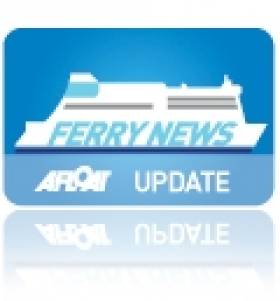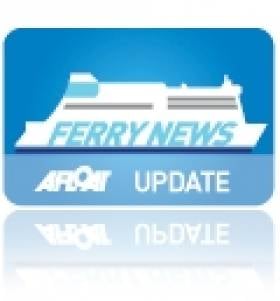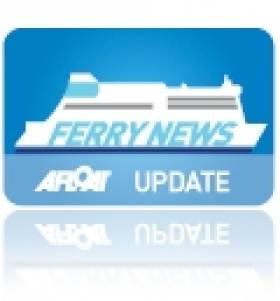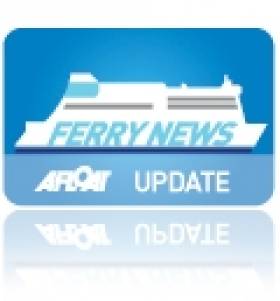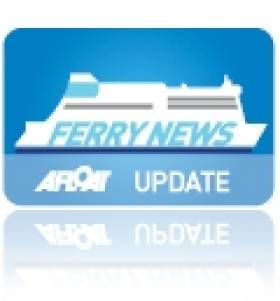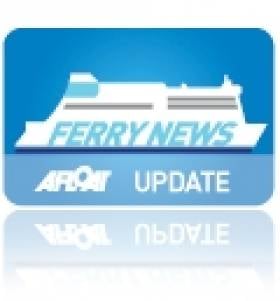Displaying items by tag: DublinHolyhead
First of Stena Line’s New Three E-Flexer Irish Sea Ships to Operate Dublin–Holyhead Service
#FerryNews - Stena Line has confirmed that the first of its new E-Flexer RoPax ferries currently under construction in China is planned to enter service on its Dublin - Holyhead route in early 2020.
Last year Stena (Stena Line’s parent company) announced a new build contract for the new generation Stena E-Flexer, with planned deliveries of the RoPax builds during 2020 and 2021. The order was for the construction of six new vessels from the AVIC Shipyard in China and the plan is to locate three of these ships on the Irish Sea.
Afloat adds the first Stena E-FLexer on the Dublin-Holyhead route is to be followed by a pair on the Belfast-Birkenhead (Liverpool) route, see related story.
The other three will be chartered out to external parties by Stena Line’s sister company Stena RoRo. Afloat adds that one Stena E-Flexer is to be chartered to DFDS for the Dover-Calais route and the remaining pair chartered to serve on Brittany Ferries UK-Spain services.
Stena Line’s CEO Niclas Mårtensson said: “Our Irish Sea routes are strategically very important to Stena Line and our customer, with the freight market between Ireland and UK experiencing significant growth over the last five years. That’s why we have invested almost £200m in our ports and vessels across the region to improve and grow our capacity to offer a frequent, reliable and high-quality service for our freight and travel customers. The deployment of three new vessels is a tangible example of our strategic growth plan for the Irish Sea”
Ian Davies, Stena Line Trade Director Irish Sea South commented: “Freight volumes have surpassed the Celtic Tiger peaks of 2007 and we are confident that this upward trend will continue. 2017 was a record year for Stena Line in the Irish Sea where we carried over 800,000 freight units on our routes to and from the Island of Ireland. We welcome the addition of the first of our new generation RoPax vessels on Dublin - Holyhead. It will significantly increase freight capacity and raise the service standards for travel and freight customers”
The new vessel being deployed on the Dublin - Holyhead route will have capacity for 1 000 passengers, 120 cars as well as 3 100 freight lane meters delivering 4 daily sailings with an estimated crossing time of approximately 3.5 hrs.
Eamonn O’Reilly, CEO of Dublin Port Company commented: “We are delighted that Stena Line has chosen Dublin as the location for its next generation of RoPax vessels in what is a significant investment in and enhancement of Ireland’s premier freight and tourism gateway. We look forward to welcoming the new vessel and the associated benefits it will bring to Dublin Port and the Irish economy.”
Niall Gibbons, CEO Tourism Ireland said: ““Stena Line’s decision to locate the first of its new generation of ferries on the Holyhead to Dublin route is a strong indication of its continued confidence in the future of tourism between Britain and Ireland. We look forward to working in partnership with Stena Line, to drive demand for its services and help grow visitor numbers from Britain to the island of Ireland in the years ahead.”
The new vessels under construction are being built in line with Stena Line’s strategic business focuses on sustainability and digitilisation with the aim of providing state-of-the-art efficiency, flexibility and customer service.
“Our new RoPax ferries will be among the most energy efficient in the world with significantly lower CO2 emissions per freight unit against comparable RoPax tonnage. Our aim is to lead the shipping industry in sustainability and digital development and set new industry standards when it comes to operational performance and emissions. The vessels will run on traditional fuel but are designed to the class notation ‘gas ready’ and are also prepared for catalytic scrubbers, thus giving us increased flexibility for the future. We are also placing heavy emphasis on developing a range of exciting new digital features which will provide our customers with unique additional services connected with their journey as well as developing a new, integrated digital onboard experience”, said Niclas Mårtensson.
Stena Line also operate other routes between Ireland and Britain, they are Belfast to Heysham (freight), Belfast to Cairnryan, Rosslare to Fishguard in addition a direct Ireland-continental service from Rosslare to Cherbourg.
Ferry Fresh from Falmouth As Ropax Returns On Horizon
#FerryNews - Fresh from a Falmouth dry-docking, Stena Horizon arrived in Dublin Port today, not Rosslare from where the ropax routinely operates on the France route to Cherbourg, writes Jehan Ashmore.
The reason for the call to the capital of the Stena Line ferry which recieved a refit at A&P Falmouth, is to facilitate further annual dry-docking cover of fleetmates. This will see Stena Horizon operate on the Dublin-Holyhead route.
Operating on this route is Stena Adventurer which will be replaced by Stena Horizon from tomorrow, 6 March 20.40hrs to 20 March 02.30hrs inclusive.
As the Stena Horizon is of a 'ropax' design (more freight orientated) compared to the 'Adventurer' there will be some reduction in facilities, products and services during this time on the Dublin-Holyhead route.
Also maintaining service as usual on the central Irish Sea route is the Stena Superfast X which was introduced in 2015.
As previously reported on Afloat, while Stena Horizon is off service on the Ireland-France route, a freight-only ship Stena Carrier is operating. The vessel is providing an important role in the export of livestock to the mainland continent until the 'Horizon's return is scheduled for 20 March.with the 21.30hrs sailing to France.
Stena Europe also fresh from overhaul in Falmouth, returned to resume Rosslare-Fishguard services.
For several days last month all Stena Line services to Wales and France were not operating 'passenger' sailings. On the Fishguard route, while Stena Europe was in Cornwall, customers were instead transferred onto a replacement ferry. This was in the form of rivals Irish Ferries whose Isle of Inishmore (see ferry focus) serves on the Rosslare-Pembroke route.
Stena Contemplating More Holyhead Ferries but Warns of A55 Congestion
#MoreFerries? - Ian Davies, Stena Line Route Director, says he might add more ferries but worries about the A55, that’s according to Wales On Line.
The ferry firm says it could bring more or bigger ships to Holyhead if freight trade continues to flourish but warned pinch points on the A55 could impact on expansion plans.
Stena Line route director Ian Davies revealed they had seen between 6% and 8% growth year on year in freight over the past two years.
With the shortest crossing over the Irish Sea the port has boomed on the back of expanding supermarket logistics with giants like Tesco and Marks and Spencer supplying their Irish stores.
To read more on Holyhead Port which has a 'bright future' said Stena Line chief ahead of Superfast X launch click here.
In addition to Afloat's coverage on board the official naming ceremony and launch of the 1,500 passenger /480 car ferry earlier this year.
#SuperfastXLaunch – Stena Line Chairman Dan Sten Olsson alongside broadcast personality Kathryn Thomas, the ferry Godmother of Stena Superfast X (pronounced 10) named the Dublin-Holyhead route's new ferry yesterday, writes Jehan Ashmore.
More than 170 guests attended the official launch ceremony in Dublin Port where Kathryn and the chairman jointly pressed a red button to unveil a nameplate in the Stena Plus Lounge.
The Dublin Welsh Male Voice Choir aptly sang 'Ireland's Call' given Stena Superfast X's launch on the core Irish Sea route and forthcoming RBS 6 Nations fixture between Ireland and Wales to be held in Cardiff, incidentally the Welsh capital is where the 30,285 tonnes ferry is registered.
Stena Superfast X was berthed at Dublin Port's Ferry Terminal 2 from where the double-tier ro-ro linkspan has already been in use in recent days as the newcomer entered service. The 1,200 passenger/ 480 car and freight capacity ferry has almost 2 kms of lane decks and this will significantly assist in boosting the important economic recovery of Irish-UK trade.
The introduction of the 30,285 tonnes ferry expands the services of the all year round Dublin-Holyhead service, one of the key tourism and freight 'gateways' between Ireland and Britain.
Dan Sten Olsson, Chairman of Stena Line said: "Trade and tourism links between Britain and Ireland have been growing steadily in recent years and with improving economic conditions forecast for 2015 and beyond, as the leading ferry operator on the Irish Sea we are confident in our ability to help stimulate this upward trend further. That's why we have invested in providing increased capacity on this route with the introduction of Stena Superfast X, a ship which is perfectly appointed to accommodate the mix of freight and tourism traffic which is required to develop the important Dublin-Holyhead gateway in the years ahead.
Mr Olsson added: "The Irish Sea is at the core of Stena Line's business which is why we have invested more than £250m in our Irish Sea routes during the last 5 years alone. Last year we added the Rosslare-Cherbourg service to our route network which has given our customers a key link between Ireland and the Continent. Industry reports point to an expected 6% increase in holiday visitors in 2015, building on the 8% increase in 2014. Stena Line recognises the importance of tourism as a key economic driver for the Irish economy. We are committed to doing all we can to provide more and more compelling reasons to travel by ferry and what better customer experience is there on the route than the new Stena Superfast X."
As previously reported on Afloat.ie, the 206m long ferry had recently underwent a comprehensive three-month refit and upgrade programme in Gdynia, Poland, to prepare her for service on the Dublin-Holyhead route.
The delivery voyage to her homeport of Holyhead as previously reported was under the command of Captain Richard Davies, who was among senior figures from the company at the launch in Dublin Port to showcase Superfast to clients, the travel trade and media.
Stena Superfast X will make two return sailings daily between Dublin and Holyhead and will operate alongside Stena Adventurer to provide a choice of up 56 Stena sailings each week on the route.
Irish Ferries Fast-Craft Sailings Cancelled
#SailingsCancelled - Due to adverse weather forecast on the Irish Sea for today (Friday 22 March), Irish Ferries have cancelled ALL Jonathan Swift 'fast-craft' sailings.
RE: Friday 22 March 2013
Due to adverse weather forecast on the Irish Sea for Friday 22 March, all Jonathan Swift fast craft sailings have been cancelled.
Ex Dublin 08.45HRS / 14.30HRS
Ex Holyhead 11.50HRS /17.15HRS
RE: Saturday 23 March 2013
Due to adverse weather forecast on the Irish Sea for Saturday 23 March, all Jonathan Swift fast craft sailings are 'Yet to be Confirmed'
EX Dublin 08.45HRS / 14.30HRS
EX Holyhead 11.50HRS / 17.15HRS
All passengers booked on these sailings will be accommodated on the Ulysses cruise ferry sailings as follows
Dublin to Holyhead 08:05/20:55
Holyhead to Dublin 02:40/14:10
For further information please call 0818300400 in Ireland / 08717300400 in the UK
NOTE: In addition to any further 'updated' sailing information available from the Irish Ferries 'FerryCheck' service by visiting this LINK.
Ferry Circles Dublin Bay Buoy in Readiness for Refit
#FERRY REFIT – In readiness for annual refit, Stena Line's Dublin-Holyhead two-ship service, is to be relieved shortly by a chartered Finnish ro-pax ferry, Finnarrow (1996/25,996grt) which carried out 'berthing trials' in Dublin Port yesterday, writes Jehan Ashmore.
When the Stena Nordica (2000/24,206grt) is away in dry-dock, Finnarrow will take her roster in tandem with the route's second ro-pax Stena Advanturer. The relief ferry is owned by Finnlines and she has a 274 passenger capacity, space for 800 cars and can handle 154-freight trailer units.
In order for Finnarrow to perform berthing procedures at the single linkspan used exclusively by Stena Line at Dublin Ferryport (Terminal 2), the Stena Nordica departed the port into the rough sea of Dublin Bay. During this time she circled the Dublin Bay Buoy and throughout the bay, before returning to the berth just vacated by Finnarrow, so to resume her scheduled afternoon sailing to Holyhead.
Finnarrow had earlier this week set sail from the German Baltic Sea port of Travemünde and arrived at the Welsh port on Wednesday lunchtime, where she also undertook berthing trails.
Ironically both Stena Nordica and Finnarrow served together on Stena Line's Karlskrona-Gdyania route several years ago, where the latter vessel was also chartered out on their Harwich-Hook van Holland route.
The Finnarrow, which unusually for a Scandinavian operator, was built in Indonesia, when ordered for original owners Rederi AB Gotland. Under her current role, she is part of the Finnlines (Grimaldi Group) of operations running 14 ro-pax vessels between six countries and eleven ports throughout the Baltic and North Sea.
Weather Conditions Cause Cancellation of Some Ferry Services
#FERRY DISRUPTION – Due to adverse weather conditions at sea, 'all' of Irish Ferries fast-craft sailings on the Dublin-Holyhead route operated by the Jonathan Swift are cancelled for tomorrow (Sunday 30 December).
Passenger booked on the cancelled 'Swift' fast-craft sailings will be transferred to alternative cruiseferry sailings served by Ulysses and Isle of Inishmore.
To keep up to date with the latest sailing schedule plus pre-recorded contact service and further information click HERE or by contacting 0818300400 in Ireland / 08717300400 in the UK. In addition check-in times are also given, which vary depending on what mode of transport is been used.
For details on other ferry operators with latest sailing information visit: www.aaireland.ie/AA/AA-Roadwatch/Ferry.aspx
Irish Ferries to Boost Dublin Route Capacity Over Festive Season
#FERRY NEWS – In an unprecedented move Irish Ferries are to operate three vessels on the Dublin-Holyhead route in the run-up to the busy festive and New Year periods, writes Jehan Ashmore.
Irish Ferries will transfer the cruiseferry Isle of Inishmore (1997/34,031grt) onto the popular central Irish Sea route linking the capital with North Wales. This will enable additional capacity of 2,200 passengers and more than 800 vehicles at a time when rivals are cutting back winter services.
The Dublin route is already served by the 'flagship' Ulysses, one of the largest car-ferries in the world and the twin-hulled catamaran Jonathan Swift which has a crossing time of 1 hour 49 minutes. The high-speed ferry which is marketed as the 'Dublin' Swift is the only fast ferry serving on the Irish Sea to operate on a year-round basis.
Isle of Inishmore is scheduled to run the additional Dublin-Holyead sailings on the following dates: 22, 23 and 27 December 2012, and on 2 and 3 January 2013. As such the Isle of Inishmore will provide an extra sailing in each direction on the central corridor route.
Head of Passenger Sales at Irish Ferries Dermot Merrigan said "So many people in the UK have Irish roots that Christmas and New Year are some of our busiest sailings".
"In previous years, bad weather has hit airports hard, sending thousands of extra passengers our way at the last minute. We're making plans now, so that whatever happens, travellers can rely on Irish Ferries to get them home in time for Christmas."
With the Isle of Inishmore's additional sailings, Irish Ferries will have the capacity to carry 6,360 passengers and 3,820 vehicles between the UK and Ireland on each of those five key dates.
On those dates, the Oscar Wilde, which usually serves between Ireland and France, will replace the Isle of Inishmore on the Rosslare–Pembroke Dock route.
Irish Ferries 'Flagship' Returns to Dublin Route
#FERRIES - Ulysses arrived fresh from refit on the Dublin-Holyhead route yesterday after annual dry-docking at Cammell Laird, Birkenhead, writes Jehan Ashmore.
As previously reported on Alfoat.ie the Irish Ferries 'flagship' sailings on the central corridor route (also served by Jonathan Swift) where relieved by Isle of Inishmore earlier this month.
Isle of Inishmore departed Dublin Port last evening and headed to Liverpool Bay, where she anchored overnight. She docked at Cammell Laird this afternoon, where she too is to undergo annual overhaul.
With Isle of Inishmore off service on her usual Rosslare-Pembroke Dock route, the company's French routes vessel, Oscar Wilde is maintaining sailings.
On 19th February, the Oscar Wilde resumes service on Rosslare-Cherbourg route and she will also re-open the seasonal-only operated route to Roscoff which starts in May.
Dublin Route Reduced to Single-Ship Service
#FERRIES – Stena Line's two-ship operated Dublin-Holyhead route is to be reduced to a single vessel service as from tomorrow, due to annual dry-docking requirements, writes Jehan Ashmore.
Stena Nordica (2000/24,206grt) is to go off the route for a refit from 5th-19th January. The last sailing scheduled for the ferry will be from Dublin Port at 02.15hrs on 5th January. She is scheduled to return on the 3 hour 15 minute route on 19th January with the 16.00hrs sailing from the capital.
Fleetmate Stena Adventurer will continue operating to her normal schedule while the Japanese ro-pax vessel is away for the dry-docking period. For information on route sailings schedules click HERE.
During the off-peak winter season, particularly during the months of January and February, it is common practice for ferry operators to take vessels off-service for annual dry-docking.
In addition to Stena Line, rivals Irish Ferries today started a fleet logistic operation as vessels are taken off and on routes for dry-docking and replaced with temporary tonnage, as previously reported on afloat.ie


























